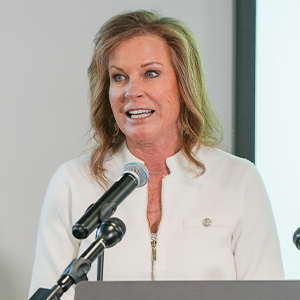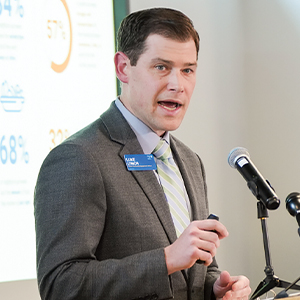Writer: Kyle Heim
Photos: Betsy De Glopper of Community Foundation of Greater Des Moines
With a renewed focus on collaboration, leaders from food banks, pantries and other anti-hunger organizations across the state are calling everyone to the table to fight food insecurity.
In February, a year after the Food Bank of Iowa and Des Moines Area Religious Council announced a new food-rescue partnership, moving past monthslong conflict over differences in their distribution networks, the groups’ leaders introduced the new Central Iowa Food Security Plan to tackle the rising challenge of food insecurity in the area.

The plan was funded by the United Way of Central Iowa and the Community Foundation of Greater Des Moines and unveiled during an event in February at the C3 Center in Des Moines. It calls for a united, collaborative response that “aims to address food insecurity equitably, respectfully and with dignity.”
The plan offers four goals for tackling the issue:
- Offer a welcoming and dignified experience for neighbors in need of food and services through an accessible and connected network of providers.
- Develop, advocate and implement policy solutions that are informed by data and voices of people with lived experience to improve the quality of life for neighbors facing food insecurity.
- Tell the story of food insecurity in Central Iowa through an intentional, collaborative and equitable data collection process to better inform services design and decision-making.
- Grow stronger together by honoring neighbors’ lived experiences and building a collaborative and connected community.
Scott Raecker, the executive director of Drake University’s Robert D. and Billie Ray Center who facilitated the plan with Jordan Vernoy of See What I Mean Consulting, said previous efforts succeeded in meeting the short-term needs of the hungry population, but those needs have escalated.
Raecker said the new plan addresses two key questions: “How do we feed the hungry neighbor today and tomorrow?” and “How do we reduce that need and build a system long-term to meet whatever needs still exist?”
He emphasized the plan’s double focus, on the present and future. “A lot of times, what communities and organizations go after, and rightfully so, is ‘We gotta meet that short-term need. We got hungry people. What do we do to meet the need today?’” he said. But those urgent demands can hamper more lasting solutions. As Raecker and the planning team heard from various leaders, including those at the Urbandale Food Pantry, staff and volunteers are often so busy meeting basic needs that they don’t have time to get to know folks, “to sit down and strategically plan and think of how we make sure that family doesn’t have to come again.”
Data gathered for the new plan shows that in Central Iowa, including Polk, Dallas and Warren counties, 6.8% of the population faces food insecurity. The rate for children is 8.9%.
Raecker said one of the plan’s first steps is to identify who will measure its progress. He explained that the OpportUNITY Food Insecurity workgroup will share collective accountability. That group includes Nalo Johnson of Mid-Iowa Health Foundation, Matt Unger of the Des Moines Area Religious Council, Michelle Book of the Food Bank of Iowa and others who will collect and share data.
“There are some big-rock numbers you can look at, like, ‘Has the need gone down?’” Raecker said. “In fact, I think you might see the need go up because if one of the things we do is communicate with people where the resources are, and they have access to them, I actually think you could potentially see the needs go up even more before it would plateau and come down. Whether that’s the number of site visits or pounds of food distributed, those are all metrics we can use that will paint part of the picture.”
The workgroup also plans to measure the engagement of various sectors – public, private and nonprofit. Everyone can pitch in.
“You have the first-grader that hears about the need and mobilizes the other first-graders, and they all bring in three cans of food,” Raecker said. “If every school in the state, in the county, in Central Iowa is doing that, we would help meet that need.”

Luke Lynch, senior community engagement officer for United Way of Central Iowa, said as the plan moves forward, the workgroup will help determine the metrics, the goals and the strategies to achieve them. Those will likely evolve in the months and years ahead.
“We’ve got to move forward,” Lynch said. “We can’t just sit around and wait to move. The metrics may change as we learn more, as there’s more usage in the community. If one of our goals is to drive down the number of usage in pantries … and if we find out that it ends up going up, that’s a story we can tell the community. The community piece is so important.”
Lynch said the workgroup has met twice since they rolled out the initial plan, with more action expected in the following months.
In April, more than a dozen leaders at food banks, food pantries and other anti-hunger organizations added their name and comments to a news release about rising food insecurity in Iowa.
Growing Pains
Food banks and food pantries began experiencing a dramatic increase in demand in April 2022, when pandemic-era emergency allotments for the Supplemental Nutrition Assistance Program (SNAP) ended.
Currently, 266,000 Iowans are enrolled in SNAP, the lowest number in nearly 16 years. The state’s eligibility requirements have also tightened.
Last summer, Iowa Gov. Kim Reynolds signed a bill that requires Iowa families receiving SNAP funds to undergo a new asset test before obtaining food assistance. The law prevents Iowa households from receiving SNAP benefits if they have more than $15,000 in liquid assets, excluding the value of a home, the household’s first car and up to $10,000 of the value of a second household car. The law also requires regular eligibility checks for several public assistance programs, including SNAP.
“In the months since SNAP pandemic allotments were cut, food pantries in the Des Moines metro haven’t had a chance to catch their breath,” DMARC CEO Matt Unger said in the news release from April 2024. “Today, more than 1 in 3 people utilizing the DMARC Food Pantry Network had previously never done so. I guarantee this precipitous rise in need includes people you actually know. It’s children in your kid’s classroom, it’s your elderly neighbor across the street, it’s the person who made your coffee this morning, it might even be a close friend or family member. People are desperate for us to find solutions that strengthen the systems they’re relying on during an incredibly challenging time.”
The release came a month after Common Good Iowa published the ninth edition of “The Cost of Living in Iowa,” which showed that 1 in 6 full-time Iowa workers earns income that falls short of affording a basic-needs budget.
In February, the U.S. Department of Agriculture reported that the all-food Consumer Price Index (CPI) rose by 25% from 2019 to 2023, a higher increase than the all-items CPI, which increased 19.2% over the same period.
“I just think everybody should be able to go to the grocery store and buy what they need to feed their family, but that is just simply not the case,” Michelle Book said.
Some of the biggest contributors inhibiting people from buying food for their family, Book said, are stagnant wages, expensive housing, part-time positions that don’t provide benefits and the rising cost of day care.
To meet basic needs, according to Common Good Iowa, a single parent with one child needs to earn at least $24.64 per hour, and two working parents with two children each require $19.55 or more per hour. A single working person must earn a minimum of $14.82 per hour.
While wages have ticked up in the past two years — the median wage in Iowa increased from $19.19 in 2021 to $21.32 in 2022, a gain of 11% — a quarter of working Iowans still make less than $15.17 per hour.
“It will take a good amount of collaboration for us to come together to meet the need. None of us can afford to work in a silo,” Book said. “At the Food Bank of Iowa, our job is to find food, keep it safe and deliver it to the doors of over 700 partners across our geographic service area. We cannot get food to the neighbors in need without collaboration and partnership.”

Left to right: Nalo Johnson, Mid-Iowa Health Foundation; Michelle Book, Food Bank of Iowa; Matt Unger, Des Moines Area Religious Council; Patty Sneddon-Kisting, Urbandale Food Pantry; Angie Dethlefs-Trettin, Community Foundation of Greater Des Moines.











